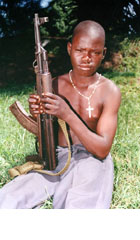
Children of War 200?
Distributed by Filmakers Library, 124 East 40th Street, New York, NY 10016; 202-808-4980
Produced by the Henrik Grunnet and Keld Kluwer for DR TV
Director n/a
VHS, color, 45 min.
Sr. High - Adult
African Studies, Political Science, Postcolonialism, Sociology
Date Entered: 11/09/2018
Reviewed by Thomas J. Beck, Auraria Library, University of Colorado at DenverIn Central Africa, in the northern most part of Uganda, children are being abducted from their homes and forced to fight in a brutal civil war. Their abductors belong to the Lord's Resistance Army (LRA), a violent revolutionary group which uses brainwashed and terrified children to fill the ranks of its army. Approximately 10,000 children, some as young as 9 or 10, have been kidnapped for this purpose in the last 16 years. Some have escaped, and they struggle to remake their lives after the terrible things they have seen, suffered and been forced to do. Save the Children - Denmark is working to help these young people to heal themselves emotionally and psychologically, and also to reunite them with their families.
The LRA is led by a religious fanatic named Joseph Kony. He believes that the Holy Spirit has directed him to rule the country according to the 10 commandments, and that he should abduct children and make them into soldiers to achieve that end. He has found that they make very effective fighters, because they are usually obedient and generally lack the abstract thinking necessary to appreciate the horrible things they are expected to do. As a consequence, they are often pitiless and relentless killers! It is estimated that Kony has 6000 child soldiers, who make up approximately 90% of his army. The LRA regularly raids and plunders villages in northern Uganda, and carries off many children every year. The boys are beaten and terrorized so they will become obedient fighters, willing to kill, torture or give their lives at their master's command. The girls are made into bearers for the army and sex slaves for Kony's officers. They frequently contract HIV/AIDS as a result, and often become pregnant and have children by their captors, making many hesitant to attempt escape for fear they will have to leave their babies behind.
Some children have managed to flee their captors, but many find they cannot return home. Kony makes a practice of forcing his child soldiers to attack their own villages, so they will alienate the people there and then be afraid to ever go back. This fear is well founded, as many of them are spurned by their families and neighbors when they try to return. Whether they are accepted or not, they all have severe psychological problems that require therapy and counseling before they can lead normal lives. Thanks to Save the Children Denmark, the Gusco Camp was established in Uganda for that purpose. There the children are counseled on how to cope with their grief, guilt and trauma. The camp counselors reminded them that they were forced to do the terrible things they did and as a consequence are not responsible. They ask them to draw their worst experiences, as a way of confronting and dealing with them. They also ask them to draw what they love most, so they can reconnect with the person they were before they were abducted and brainwashed. Eventually the counselors have the children reenact the violent raids and attacks in which they were involved (using toy weapons), so they can work though the trauma associated with them in a safe environment. These various therapeutic techniques allow them to face and overcome their demons and become children again.
John Rheinstein, the head of Save the Children Denmark, works to find those who have escaped and bring them to Gusco. The film profiles two of these children, Judith and Dennis. Rheinstein's work includes finding and reuniting them, and the other children, with their families. Dennis' family is not found, but Judith's is! Even with that accomplished however, she must wait a while longer before going home, so her therapy can be completed. As already indicated, the children's psychological and emotional problems will eventually overwhelm them without proper care, so this delay, as difficult as it may be, is still necessary. While Judith and her Mother wait for her return, Rheinstein works to save the lives of child soldiers who are still fighting for the LRA. The Ugandan Army has launched a massive offensive against Kony's army which has put him and his soldiers on the run. Unfortunately most of the casualties of this war are the child soldiers of the LRA. Rheinstein encourages the Ugandan authorities to take better care to protect the lives of these undoubtedly terrified children, but too little effect. The authorities see any enemy soldier who has not surrendered as a potential target, regardless of age. Rheinstein points out that the international community has egregiously failed these children, by allowing them to be abducted, raped and tortured for so many years. It is ironic that many of them will now be killed to destroy the organization that kidnapped and abused them! The film ends with Judith reunited with her family and friends, but with Dennis still waiting for his to be found. The question of what will become of him and the other children like him, as well as those who are still in the LRA or who have yet to be abducted, remains unresolved.
This film is moving, informative and well paced, and its sound and picture qualities are good. It is almost entirely in Danish or various African languages, with English subtitles.